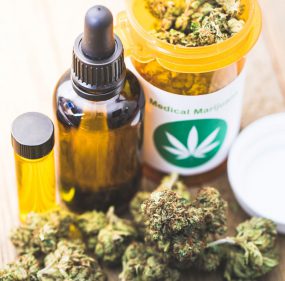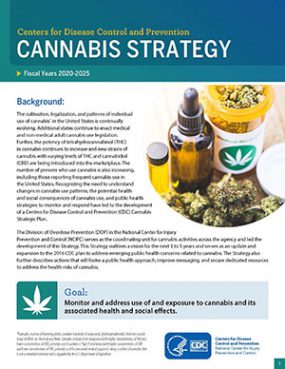What CDC is Doing

The cultivation, legalization and patterns of individual use of cannabis* in the United States is continually evolving. Additional states continue to enact medical and non-medical adult cannabis use legislation. Further, the potency of tetrahydrocannabinol (THC) in cannabis continues to increase and new strains of cannabis with varying levels of THC and cannabidiol (CBD) are being introduced into the marketplace. The number of persons who use cannabis is also increasing, including those reporting frequent cannabis use in the United States. Recognizing the need to understand changes in cannabis use patterns, the potential health and social consequences of cannabis use, and public health strategies to monitor and respond have led to the development of a CDC Cannabis Strategic Plan.
The Division of Overdose Prevention (DOP) in the National Center for Injury Prevention and Control (NCIPC) serves as the coordinating unit for cannabis activities across the agency and led the development of this Strategy. This Strategy outlines a vision for the next 3 to 5 years and serves as an update and expansion to the 2016 CDC plan to address emerging public health concerns related to cannabis. The Strategy also further describes actions that will foster a public health approach, improve messaging, and secure dedicated resources to address the health risks of cannabis.
*Cannabis, a genus of flowering plants, contains hundreds of compounds (phytocannabinoids) that have a wide range of effects on the body and brain. Cannabis includes both marijuana (with higher concentrations of THC and lower concentrations of CBD, primarily used to achieve a “high”) and hemp (with higher concentrations of CBD and lower concentrations of THC, primarily used for presumed medical purposes). Hemp is a form of cannabis that is not a controlled substance but is regulated by the U.S. Department of Agriculture.
Monitor and address use of and exposure to cannabis and its associated health and social effects.
- Analyze and expand existing data sources to monitor adult and youth medical and nonmedical cannabis use. Examples of trends we intend to focus on include ED visits, mode of use, age of initiation, frequency of use, and polysubstance† use.
- Develop new systems to assess cannabis use (product type, amount, mode, and frequency) and health and social outcomes
- Evaluate how state, tribal, local and territorial policies may affect use patterns and health outcomes
- Identify risk and protective factors for use and health and social outcomes
- Support peer-to-peer learning among STLTs
- Provide guidance for emergency responses due to emerging harms
- Advance application of a public health framework to STLT cannabis policy
- Build relationship with tribal coalitions for on-reservation considerations for cannabis policy
- Disseminate and integrate the evidence on benefits and harms of cannabis
- Develop healthcare provider education and tools
- Identify healthcare screening tools and protocols
- Engage with substance use prevention community-based coalitions
- Support development and implementation of evidence-based programs for schools and communities
- Identify public health and public safety data-sharing models
- Conduct public health message testing
- Develop and implement public education materials
- Evaluate campaigns
†Polysubstance drug use occurs with exposure to more than one drug, with or without the person’s knowledge.
Physical and mental health, and social effects of interest:
- Initiation and use
- Substance use disorder
- Poisoning
- Occupational injury
- Motor vehicle crash injury
- Employment
- Cardiopulmonary conditions
- Environmental exposure
- Developmental outcomes
- Prenatal and pregnancy complications
Populations of interest:
- Adolescents and young adults
- Older adults
- Infants and young children
- Pregnant/postpartum women
- Workers
- Racial and ethnic minorities
- People in poor health or with chronic conditions
Analyze, improve, and expand CDC data systems, including the Youth Risk Behavior Surveillance System, Behavioral Risk Factor Surveillance System, and Pregnancy Risk Assessment Monitoring System.
Evaluate how medical and nonmedical state, tribal, local and territorial cannabis policies affect medication prescribing (including for opioids), health outcomes, and drug overdose.
Facilitate technical assistance among STLT agencies on cannabis surveillance, identifying key indicators and best practices of existing surveillance systems that can inform cannabis surveillance.
Review the evidence of the effectiveness of cannabis as a medical treatment, such as for pain management and the treatment of opioid use disorder and inform continuing medical education.
Offer opportunities to prevention community-based coalitions to learn about evidence-based substance-use-prevention strategies to address youth cannabis use.
Develop web content and fact sheets to educate the public, including populations such as youth, pregnant women and workers, on the benefits and harms of cannabis use.
For questions or technical assistance, please contact the Cannabis Strategy and Coordination Unit at cannabisTA@cdc.gov
